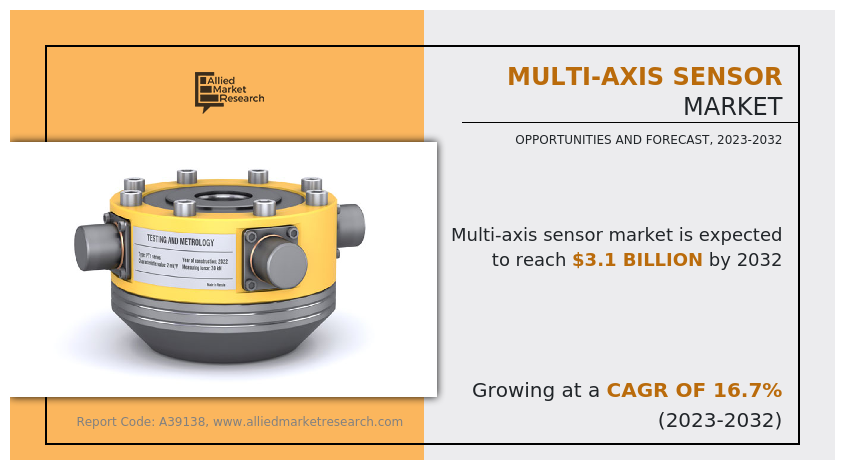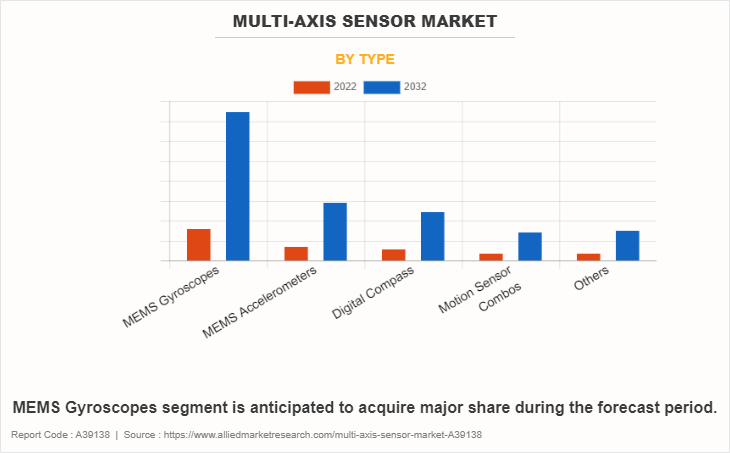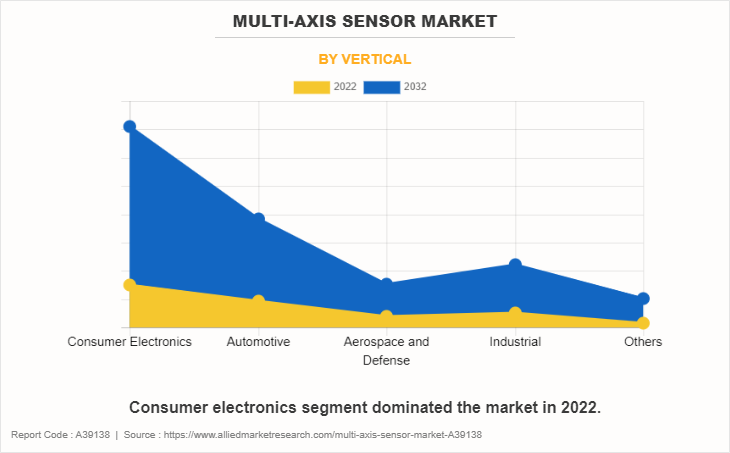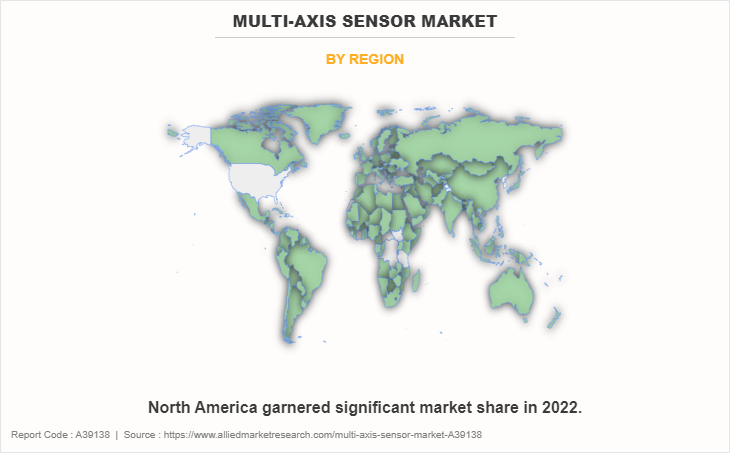Multi-Axis Sensor Market Research, 2032
The Global Multi-Axis Sensor Market was valued at $693.8 million in 2022, and is projected to reach $3.1 billion by 2032, growing at a CAGR of 16.7% from 2023 to 2032.
A multi-axis sensor, often known as an accelerometer or gyroscope, is a sensing device that can measure acceleration or angular velocity in numerous directions at the same time. These sensors are used to accurately monitor and control motion and orientation in several axes or dimensions in a variety of applications such as robotics, aerospace, automotive, and consumer electronics.
Multi-axis sensors are critical for obtaining high levels of precision and responsiveness in a variety of technical applications, allowing equipment to detect and respond in real-time to complicated motions and orientations. They are critical in improving the functioning and performance of a broad variety of devices and systems.
Multi-axis sensors provide substantial benefits in various applications as they can simultaneously measure multiple physical parameters within a single sensor unit. These sensors enhance efficiency, precision, and functionality across a wide range of industries. By integrating sensors for multiple axes of measurement, like acceleration, rotation, and magnetic field, into one device, they offer a comprehensive understanding of an objects movement and orientation. This versatility proves especially valuable in fields like automotive safety systems, where multi-axis sensors can detect abrupt accelerations and rotations, allowing for airbag deployment and vehicle stability control. In industrial contexts, they enable precise control and feedback in robotics, ensuring precise and smooth motions. In addition, multi-axis sensors are applied in consumer electronics such as smartphones and gaming consoles, enabling screen rotation and motion-based gaming. These sensors simplify system design, reduce space and power requirements, and cut overall expenses. Their capacity to deliver a comprehensive perspective on physical parameters is invaluable for applications that require precise measurement and control in multiple dimensions, ultimately enhancing safety, performance, and user interactions.

The factors driving the market include technological improvements that enable effective components to be lighter and smaller in size, the rapid increase of unmanned vehicles in both defense and civil applications, and the expanding applications based on motion sensing.
The increased usage of motion sensing-based applications is projected to boost the multi-axis sensor. However, the difficulty of integrating them into current systems is limiting their usage. Furthermore, a high-performance sensor fusion to improve the accuracy of multi-axis sensor systems to enable newly emerging and highly demanding applications such as indoor navigation and location-based services (such as IoT) is expected to offer significant market growth potential.
The primary objective of multi-axis sensors is to provide a comprehensive and versatile solution for the precise measurement and monitoring of physical parameters across multiple dimensions. These sensors are designed to capture data simultaneously from various axes, such as acceleration, rotation, and magnetic fields, offering a holistic view of an object's movement and orientation. Their versatility allows them to serve a wide array of applications, from automotive safety systems, where they detect sudden changes in velocity and orientation to trigger airbag deployment and ensure vehicle stability, to industrial robotics, where they enable accurate and smooth motion control. In consumer electronics, multi-axis sensors facilitate features like screen rotation, multi axis gyroscope, multi axis force sensor, multi axis load cell and motion-based gaming in smartphones and gaming consoles, enhancing the user experience. By consolidating these measurement capabilities into a single sensor unit, multi-axis sensors simplify system design, reduce space requirements, and minimize energy consumption, ultimately driving cost efficiency. Whether in improving safety, enhancing performance, or enabling new user interactions, the fundamental aim of multi-axis sensors is to empower industries and technologies by providing a comprehensive understanding of physical parameters in multiple dimensions, leading to more efficient, accurate, and versatile systems.
Segment Overview
The multi-axis sensor market forecast is segmented into type and vertical.

By type, the multi-axis sensor market growth is classified into motion sensor combos, MEMS gyroscopes, MEMS accelerometers, digital compass, and others. In 2022, the MEMS Gyroscopes segment dominated the market, in terms of revenue, and is expected to follow the same trend during the forecast period.

As per vertical, the multi-axis sensor market size is divided into consumer electronics, automotive, aerospace and defense, industrial, and others. The consumer electronics segment acquired the largest share in 2022 and is expected to grow at a significant CAGR from 2023 to 2032.

By region, it is analyzed across North America (the U.S., Canada, and Mexico), Europe (France, Germany, UK, and rest of Europe), Asia-Pacific (China, Japan, India, South Korea, and rest of Asia-Pacific), and LAMEA (Latin America, Middle East and Africa). North America region, especially U.S. remains a significant participant in the multi-axis sensors market.
Competition Analysis
Competitive analysis and profiles of the major global multi-axis sensors market players that have been provided in the report include, Parker Hannifin, Trimble Navigation Limited, STMicroelectronics, Aeron Systems Private Limited, Honeywell International Inc., Interface Inc., Texas Instruments Inc., ATI Industrial Automation, Inc., L3Harris Technologies, Inc., and Jewell Instruments LLC. These key players adopt several strategies such as new product launch and development, acquisition, partnership and collaboration and business expansion to increase the multi-axis sensor market share during the forecast period.
Region Analysis
North America-wise, the U.S. acquired a prime share in the multi-axis sensors market in the North American region and is expected to grow at a CAGR of 17.51% during the forecast period of 2023-2032. The U.S. has highest market share in 2022 owing to its rapid expansion over the past few years. For instance, in June 2021, a new rate sensor designed to aid compact satellites navigate crowded orbits over the Earth’s surface was introduced by Honeywell. However, Mexico is expected to exhibit to be the fastest growth during the forecast period.
In Europe, the UK dominated the Europe Multi-axis sensors market share in terms of revenue in 2022 and is expected to follow the same trend during the forecast period. However, Germany is expected to exhibit to be the fastest growth during the forecast period owing to rise in demand for multi-axis sensor in automotive sector across the region.
In Asia-Pacific, China holds a dominated market share in Asia-Pacific region and is expected to follow the same trend during the forecast period, owing to its large and growing market, to increase in technological advancements and increasing use of multi-axis sensors in the thriving consumer electronics and automotive sectors. However, India is expected to emerge as a dominated country in multi-axis sensors market in Asia-Pacific region.
In LAMEA, the Middle East is growing the fastest in the multi-axis sensors. In the Middle East, the growth of the multi-axis sensors market is driven by rapid urbanization and population expansion, there is a rising need for security. The increasing adoption of multi-axis sensors in hospitality and retail sectors. Moreover, the Middle East is anticipated to grow at a high CAGR of 17.84% from 2023 to 2032, owing to its economic growth in this region.
Top Impacting Factors
Significant factors impacting the growth of the market include a rise in need for motion sensors in automotive industry and growing installation and adoption of MEMS accelerometers in high-end applications. However, highly complex manufacturing process and demanding cycle time may hamper market growth. Furthermore, the surge in need for motion sensors in the automotive industry provides lucrative opportunities for market growth.
Historical Data & Information
The multi-axis sensors market is highly competitive, owing to the strong presence of existing vendors. Vendors of multi-axis sensors machines with extensive technical and financial resources are expected to gain a competitive advantage over their competitors because they can cater to market demands. The competitive environment in this market is expected to increase as technological innovations, product extensions, and different strategies adopted by key vendors increase.
Key Developments/ Strategies
Parker Hannifin, Trimble Navigation Limited, STMicroelectronics, Aeron Systems Private Limited, and Honeywell International Inc. are the top 5 companies holding a prime share in the multi-axis sensor market overview. Top market players have adopted various strategies, such as product launch, contract, acquisition, and agreement, to expand their foothold in the multi-axis sensors market.
- In July 2023, STMicroelectronics, a global semiconductor leader, unveiled a FlightSense. multi-zone distance sensor with an industry-best 90-degree field of view, enhancing situational awareness for smart equipment applications. The VL53L7CX sensor offers various applications, including presence detection, object-detection, and scene-mapping, making it suitable for home automation, robotics, and more.
- In August 2023, ATI Industrial Automation achieved compatibility between their Multi-Axis Force/Torque Sensors and FANUC Robots with Force Control Software in August 2023, enhancing robotic sensing capabilities. This collaboration facilitated precise control for tasks such as assembly and material removal, benefiting industries like automotive and aerospace.
- In September 2023, L3Harris Technologies expanded its European presence with an advanced electro-optical/infrared (EO/IR) engineering and manufacturing facility in Poland. The 2,800-square meter facility served European and international customers with advanced EO/IR sensor systems. This move aimed to enhance local partnerships and operational readiness while fostering cross-functional efficiencies and employing skilled staff.
Key Benefits For Stakeholders
- This report provides a multi-axis sensor market analysis of the market segments, current trends, estimations, and dynamics of the market analysis from 2022 to 2032 to identify the prevailing multi-axis sensor market opportunities.
- The market research is offered along with information related to key drivers, restraints, and opportunities.
- Porter's five forces analysis highlights the potency of buyers and suppliers to enable stakeholders make profit-oriented business decisions and strengthen their supplier-buyer network in multi-axis sensor industry.
- In-depth analysis of the market segmentation assists to determine the prevailing multi-axis sensor market opportunity.
- Major countries in each region are mapped according to their revenue contribution to the global multi-axis sensor industry.
- Market player positioning facilitates benchmarking and provides a clear understanding of the present position of the market players.
- The report includes the analysis of the regional as well as global multi-axis sensor market trends, key players, market segments, application areas, and market growth strategies.
Multi-Axis Sensor Market Report Highlights
| Aspects | Details |
| Market Size By 2032 | USD 3.1 billion |
| Growth Rate | CAGR of 16.7% |
| Forecast period | 2022 - 2032 |
| Report Pages | 326 |
| By Type |
|
| By Vertical |
|
| By Region |
|
| Key Market Players | Trimble Navigation Limited, ATI Industrial Automation, Inc., Interface Inc., Aeron Systems Private Limited, Texas Instruments Inc., Honeywell International Inc., Jewell Instruments, L3Harris Technologies, Inc., STMicroelectronics, Parker Hannifin |
Analyst Review
The multi-axis sensor market is expected to leverage high potential for the MEMS gyroscopes and MEMS accelerometers during the forecast period. Multi-axis sensor vendors, investing substantially in R&D and skilled workforce, are anticipated to gain a competitive edge over their rivals. The competitive environment in this market is expected to further intensify with an increase in technological innovations, product extensions, and different strategies adopted by key vendors.
The surge in demand for multi-axis sensors in consumer electronics and automotive around the world for security is driving the need for enhanced multi-axis sensors. Moreover, major economies, such as the U.S., China, the UK, and Japan plan to develop and deploy advanced multi-axis sensors in various sectors.
Key multi-axis sensor market leaders profiled in the report include Parker Hannifin, Trimble Navigation Limited, STMicroelectronics, Aeron Systems Private Limited, Honeywell International Inc., Interface Inc., Texas Instruments Inc., ATI Industrial Automation, Inc., L3Harris Technologies, Inc., and Jewell Instruments LLC.
The upcoming trends in the Multi-Axis Sensor Market include the proliferation of MEMS (Micro-Electro-Mechanical Systems) technology, increased demand for sensors in autonomous vehicles and robotics, and the integration of Artificial Intelligence (AI) for enhanced sensor capabilities and applications.
Consumer electronics is the leading application of multi-axis sensor market.
North America is the largest regional market for multi-axis sensor.
The global multi-axis sensor market was valued at $693.8 million in 2022.
Parker Hannifin, Trimble Navigation Limited, STMicroelectronics, Aeron Systems Private Limited, Honeywell International Inc., Interface Inc., Texas Instruments Inc., ATI Industrial Automation, Inc., L3Harris Technologies, Inc., and Jewell Instruments are the top companies to hold the market share in Multi-Axis Sensor.
Loading Table Of Content...
Loading Research Methodology...



